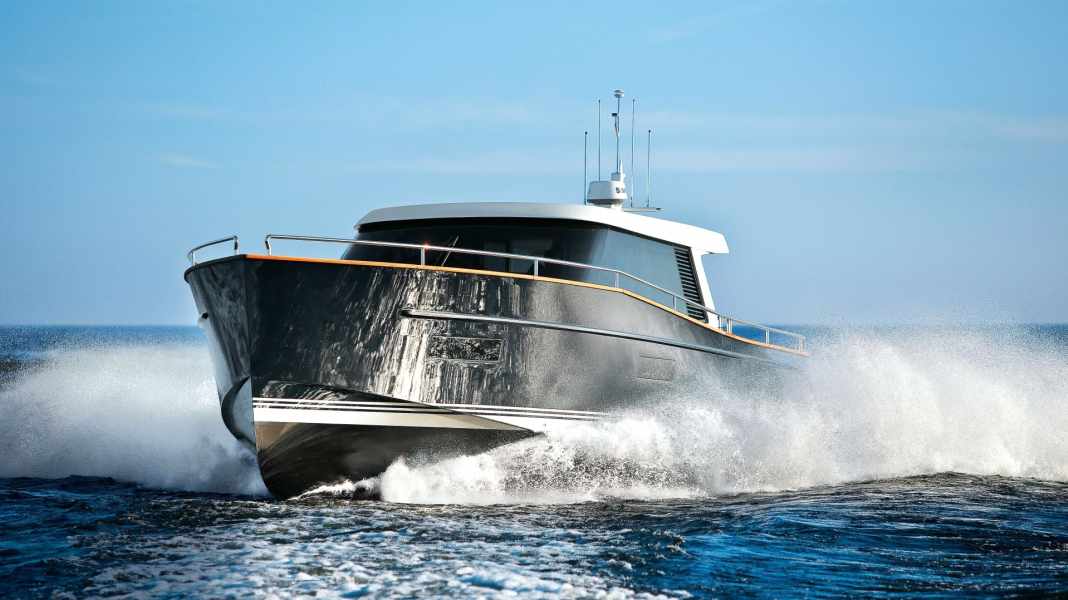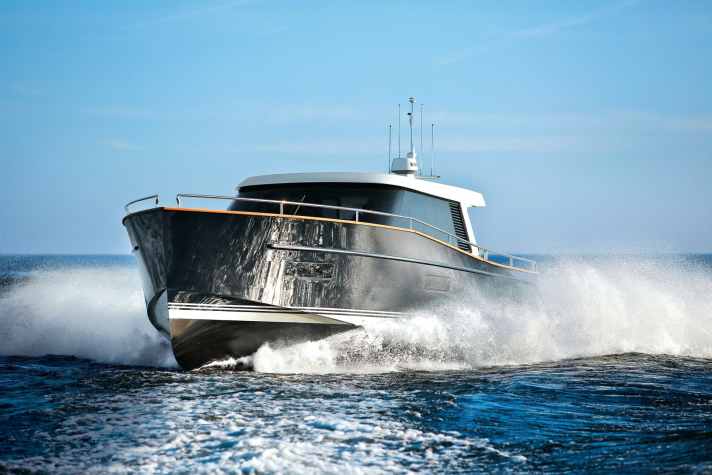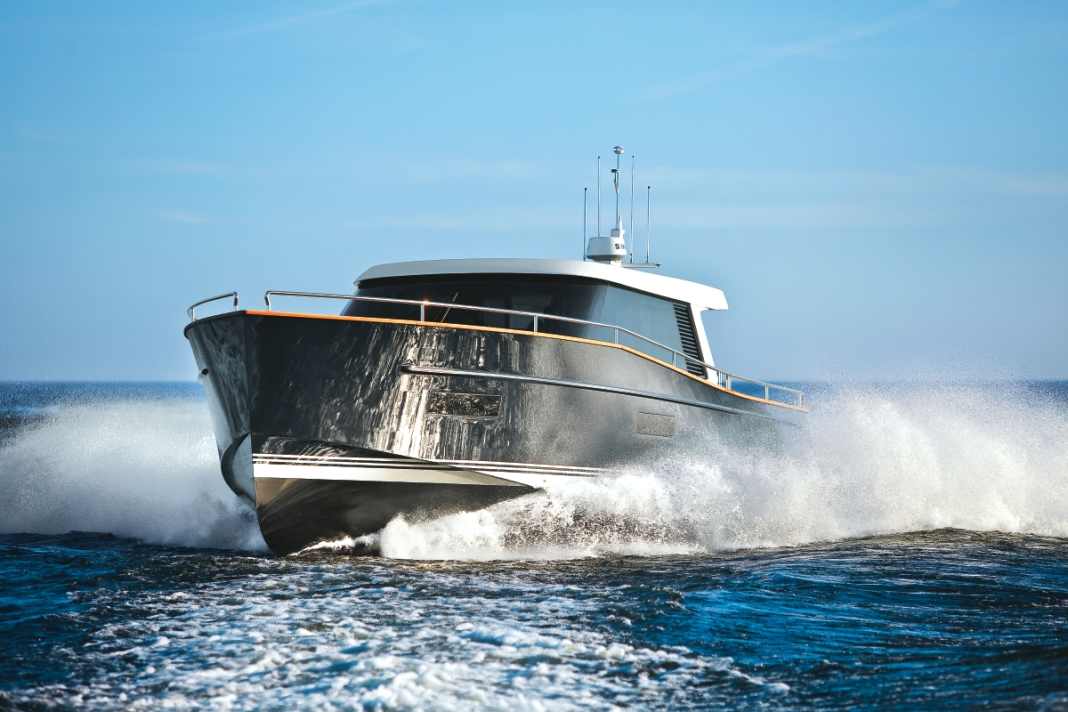







What does a sailboat yard do when its mostly older customers want (or have to) retire from sailing but don't want to give up boating? They build their own motorboat. This was the case with our test boat, the Contest MC 52 from Medemblik in the Netherlands. "However, our MC 52 is not only intended to inspire people who are changing over, but also motorboat enthusiasts in general," says Annick Conijn, Press Relations and Marketing at Contest.
The good name that Contest has built up over five decades in the sailing boat industry is naturally something they also want to transfer to the motorboat. The first guarantee for this is the collaboration with the designer Georg Nissen and the Naval Architects from Vripack (see also BOOTE3/13).
For the construction of the hull and deck, the shipyard uses the vacuum injection method to give everything solid strength and low weight at the same time. The result is a 16.6 tonne semi-glider with a first-class design and elegant interior. The workmanship of our test boat (build number 1) makes a good, solid impression overall. The cable routing using the cable platform in the engine compartment is also meticulous. Two Cummins diesels are installed on the solid foundations in the latter. The shipyard recommends engines with 305 hp as standard.
However, we travelled with a powerful "power injection" with almost twice the performance. The two 8.3-litre diesels have a combined output of 1202 hp and accelerate the Contest to almost 28 knots. If you look at the fuel consumption in this situation (a good 3000 rpm), it must be clear to everyone that two 600 hp diesels together require around 250 l/h (8.7 l/sm). With a fuel supply of 1800 litres minus 15% reserve, this results in a range of just under 180 nm. If the engine speed is reduced to 2300 rpm at 19 knots, the theoretical range is still 275 nm. Real long distances can be achieved by reducing the engine speed to displacement speeds. With a low hull speed of 9 kn, the boat-motor combination can then cover a distance of around 1000 nm.
In fast or slow displacement mode, the Contest runs well in a straight line and requires very little correction. The transition to fast speed is between around 1500 rpm and 2300 rpm. The driver should lower the trim tabs so that visibility is only disturbed briefly. It is advisable to use the trim tabs for the entire fast run in order to bring the 52 MC into the optimum position.
Course stability and, above all, rough water behaviour are convincing at high speed. At wind force 4 to 5 Beaufort on the Ijsselmeer, the Contest sails through rough seas smoothly, true to course and dry. Even in fast, tight turns, the 52-MC hull shows no weaknesses such as hooking or rocking. The only drawback: in port bends, the lean angle restricts the driver's view of the inside of the bend.
If the speed is reduced, a so-called seakeeper (at an additional cost of just under 90,000 euros) ensures a stable position in this situation. This device is also designed to ensure that the boat is as rock-free as possible when anchored. Harbour manoeuvres can be carried out with both thrusters (1 x forward, 1 x aft) without any problems. In order to leave or reach the berth at an appropriate speed, our test boat uses the trolling device, which reduces the speed from around 5 knots to a minimum of 1.5 knots at idle speed.
The skipper drives from a firmly upholstered pilot's seat that can be adjusted in all directions. The skipper has plenty of knee room and a folding step to rest their feet in comfort. A double bench is available for the co-driver, which also offers plenty of legroom. The passenger can only hold on to the backrests; a grab handle is available on request.
The driver has unrestricted control of the gearstick and steering. Apart from a few reflections, the instruments are easy to read and the switches are easy to operate. The driver has an unrestricted view through the tinted safety glass windscreen when seated. Standing drivers, on the other hand, only have a height of around 1.70 metres and the lowered saloon roof in their field of vision. Large sliding glass doors and foil windows in the convertible top favour the view aft. To keep a clear view in rain and heavy seas, Contest installs two solid twin-arm wipers that create a suitably large wiping area.
The technical compartment with the two Cummins diesels is accessed via two floor hatches with gas pressure dampers. In the centre, directly above the hatches, the service technician has reasonable access to the engines, but to the sides it is cramped due to the limited headroom. The maximum measured noise level of 76 dB/A at the driver's cab shows that extensive sound insulation pays off. The two diesels also cope reasonably well with an engine compartment temperature of 32 °C. The entire well thought-out electrical system with plenty of batteries, chargers and inverters is a first-class installation.
The fire extinguishing system and the double diesel filter design (with alarm) demonstrate the high safety standards. Four electric bilge pumps automatically drain each section (can also be switched on manually). A manual bilge pump is not part of the standard equipment. Non-slip floor structures and low gangways and railings ensure a high degree of manoeuvrability.
We are not convinced by the loose bathing ladder (owner's request), which has to be hooked in before bathing in order to get back on board safely. It is stowed in the stern locker in the same way as the on-board bicycles. Alternatively, the dinghy can also be stowed here. The route from the large bathing platform leads over the wide gangways into the cockpit.
A cosy seating area with a wooden table dominates here. The lounge seating area is also cosy. Opposite it is the fully equipped galley. The sleeping cabins are located one level below: the owner's cabin in the bow with a double bed and exemplary slatted frame, a single berth in the centre to starboard and two single berths on the other side, which can be converted into a double berth in no time at all. These three berths are also ventilated. It (almost) goes without saying that the two associated heads compartments lack nothing. Another special feature in the bow: the anchor can be raised hydraulically from the self-draining anchor locker.
The owner is spoilt for choice when it comes to equipment (e.g. generator, air conditioning and sunroof) and layout, as there are three layout variants and the option of ordering the Contest as a 52 MC, 52 MC Open Sport and 52 MC Flybridge.
Conclusion: The Test-Contest 52 MC is a successful, elegant but also solid boat on which five people can travel in comfort
Data sheet: Contest 52 MC
Shipyard: Contest Yachts
Type designation: Contest 52 MC
CE category: A - High seas
Material of hull and deck: Plastic
Length: 15,93 m
Width: 4,60 m
Displacement: 16,60 t
Price: 1.141.805,00 €

